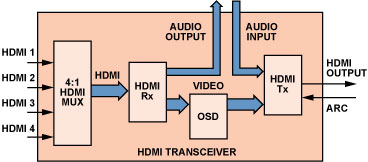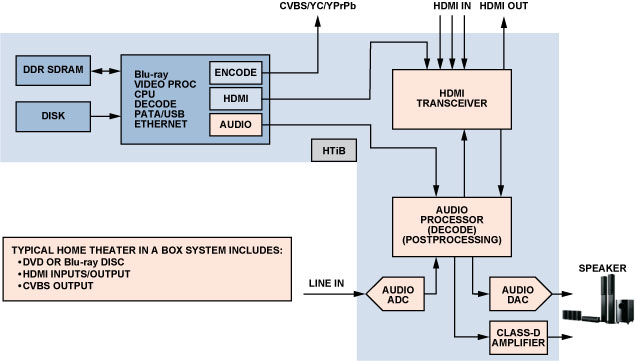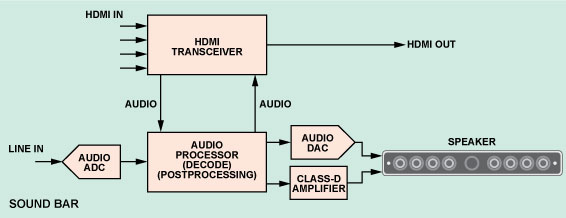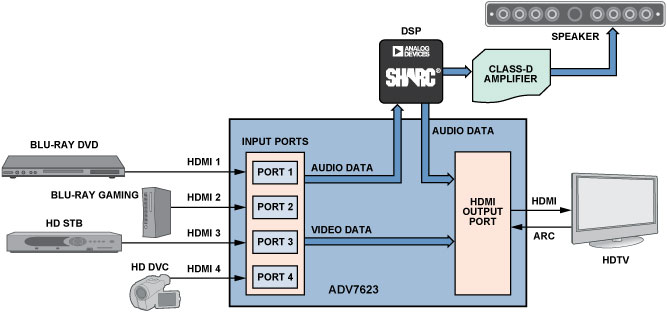Introduction
Now that large-screen HDTVs (high-definition televisions) have achieved widespread acceptance, many consumers are expanding their electronics collection to include components for a complete home theater system. Home theater in a box (HTiB), sound bars, and audio/video receivers (AVRs) enhance the user experience with superb audio while complementing the HDTV video performance. The ability to extract and process high-fidelity audio signals is a key differentiator among the hardware choices on the market today. Home theater systems can now offer all the latest features of the High-Definition Multimedia Interface (HDMI®)—seamlessly integrated within the equipment.
The effort to improve the home theater experience comes with several implementation challenges for the system designer of HTiBs, sound bars, and AVRs. The latest version of the HDMI standard includes new optional features, such as an audio return channel (ARC), 3D display formats, and enhancements to the consumer electronics control (CEC) protocol. Consumers, of course, want their new home theater equipment to include all of these new HDMI features—at lower cost and with more user-friendly controls. Designers of home theater equipment must thus adapt to the new standards, while shrinking their bill-of-material (BOM) costs, development costs, and time to market. To help designers meet these challenges, Analog Devices has created HDMI transceiver products that incorporate these new features.
An example of an HDMI transceiver is the ADV7623, which incorporates a 4:1 HDMI input multiplexer (mux), HDMI receiver, on-screen-display (OSD) engine, and HDMI transmitter. Individually, these functions would require discrete ICs, each with its own unique firmware, but a transceiver can combine all these functions in a comprehensive solution, reducing board area, firmware complexity, and BOM costs for the home-theater system designer.

Home Theater in a Box
HTiBs are complete video playback systems. They generally include a multichannel audio amplifier and a surround-sound speaker system for playback of audio. In addition, they usually include a DVD or Blu-ray™ video player. HTiBs ease installation and power matching between the video player, amplifier, and speakers. HTiBs principally process audio; the video is passed through to the TV over the HDMI interface. Figure 2 depicts a typical HTiB system.

Sound Bars
With the increased popularity of thin, large screen, flat panel TVs, sound bars are emerging as complementary AV systems. These are compact, easy-to-set-up speaker systems that provide much better sound quality than the TV speakers. Since most HTiBs and sound bars are used with large-screen HDTVs, their audio and video connectors mainly utilize HDMI. A typical sound bar will have multiple HDMI inputs to handle various sources, a single HDMI output for the connected TV, built-in audio processing, and speakers. Figure 3 illustrates a typical sound-bar system.

Advanced sound bars comprise multiple speakers and amplifiers with surround-sound decoding capability. Their electronic and acoustic design features can produce a surround-sound effect without separate speakers at the back of a room. Middle- to high-end sound-bar systems often contain DVD or Blu-ray players, resulting in system architecture similar to that of HTiBs.
Audio Return Channel (ARC)
A new feature in the HDMI specification provides for an audio return channel (ARC)—to allow the HTiB to process audio from the downstream device. In order to listen to the TV audio without an ARC, an independent cable (optical S/PDIF or coaxial) would be required to send the audio from the TV or tuner back to the HTiB. With the ARC, the HDMI cable can return 2-channel S/PDIF or multichannel audio from the TV back to the HTiB, dispensing with the extra audio cable. HDMI transceivers offer an ARC receiver on the HDMI output port.
ARC adds significant value in the case where the TV, set-top box, or other downstream HDMI sink device uses a tuner to receive new media content. Instead of listening to the audio over the less powerful internal TV speakers, the user can easily employ the higher fidelity HTiB system output. The returned audio data passes on the HDMI cable from the TV to the HTiB—in the opposite direction to the traditional video data path—without regard to whether or not the video output to the HTiB is active on the cable.
Extended Display Identification Data (EDID) Replication
HDMI transceivers provide an EDID replication feature that reproduces a single location memory across multiple HDMI ports—even when the HTiB is in power-down mode. This enables faster system start-up times, as all of the upstream HDMI source devices can configure their video outputs properly before the HTiB is powered up. The only power required for EDID replication is furnished by the +5 V/55 mA available from the source via the HDMI cable.
3D Video
As a bridge between 3D content-providing sources, such as game consoles, Blu-ray players, and 3D-capable TVs, HTiB manufacturers must stay ahead of the technology curve to enable customers to benefit in the long term from the full range of features offered by their source and sink devices. HDMI transceivers that incorporate the latest versions of HDMI technology support implementation of 3D video as part of the home theater experience. This new feature of the HDMI standard significantly enhances the user experience; such features are critical to energizing TV sales.
The specification defines an infrastructure for communicating 3D video in the home via a list of mandatory and optional video formats. In a practical application, the HTiB must present to the connected sources a list of supported 3D formats—retrieved from the connected TV and parsed against its own list of supported 3D formats. The connected source then indicates to the HTiB—through HDMI protocol commands—when it is sending 3D content. The HTiB can then extract and output advanced audio formats, such as Dolby TrueHD® or DTS-HD Master Audio®, that were sent over the HDMI link, but that the TV may not be equipped to support.
On-Screen Display (OSD)
HTiBs have many user-accessible controls, such as selection between multiple inputs, selection of desired audio and video formats, and configuration of advanced audio processing options. To enable control of these complex features in a user-friendly manner, an on-screen display (OSD) is employed. OSD was usually implemented via a dedicated device, but now HDMI transceivers offer integrated OSD engines to blend the desired on-screen display material onto the output video—offering HTiB manufacturers considerable savings over the external solution. Savings of component cost and bill of materials are possible, as well as reduction of design effort to integrate the OSD software into the system firmware.
Consumer Electronics Control (CEC) Expansion
The consumer electronics control (CEC) channel is a single-wire communication interface that facilitates home entertainment system networking. One example is a single remote control button that simultaneously powers all components of an entertainment system on and off. As the HDMI standard has expanded to support new optional features such as ARC and HDMI Ethernet channel (HEC), the CEC command library within HDMI transceivers has also expanded to support them. For HTiB designers, supporting the latest HDMI features requires that they also support the latest CEC features. HDMI transceivers now handle the discovery, negotiation, initiation, and termination of ARC and HEC sessions over the single-wire network.
Audio Insertion and Extraction
Another use of an HDMI transceiver within an HTiB is to extract the HDMI audio for processing with a digital signal processing (DSP) chip. The audio can then be reinserted into the HDMI stream to the TV. Since many TVs cannot handle multichannel audio formats, the DSP chip can downsample the audio to stereo and then reinsert the audio into the HDMI link to the TV.
Alternatively, the incoming audio could be completely replaced with a new stream from another HTiB source and embedded into the HDMI signal to the TV. In this case, only the audio insertion feature would be used. An example of this application could be docking an iPod® to an HTiB and mixing the audio with an independent video stream.
An HTiB system may act as an HDMI repeater when it accepts an HDMI input and also sends it as an output, in a home theater configuration. A Blu-ray player, for example, can be the source as an input to the HTiB system. In order to utilize the superior sound quality of the HTiB as compared to the connected TV, the audio must be extracted from the HDMI signal within the HTiB. In the best case, an audiophile would want a full 8-channel I2S audio signal output from the HTiB, but 2-channel I2S or S/PDIF is also available from the HDMI link. The video continues to the TV or display to complete the system path. Only an HDMI/HDCP (High-bandwidth Digital Content Protection) repeater or transceiver-type device can handle this audio extraction.
Firmware/Repeater Support
One of the biggest challenges in HTiB and sound-bar design is implementing the HDCP repeater function. The repeater function implemented in an HTiB is a complex mix of content protection, EDID management, and video- and audio muting. HDMI transceivers integrate the entire repeater process into a single device and firmware, reducing system development complexity.
As video and audio processing devices increase in complexity, the availability of qualified hardware-abstracted software libraries and application programming interfaces (APIs) becomes a major benefit to the designer—shortening time to market and making it feasible to start from a well-structured HDMI- and HDCP-compliant platform. Further savings can be made by initially adopting the shared code base of a silicon vendor: the rewards of integrating the code for a transceiver in low- to mid-end HTiBs can be reaped in the upgrade possibilities when using discrete receivers and transmitters from the same vendor in mid- to high-end HTiBs.
2-Layer Circuit-Board Design for Cost Savings
New HDMI transceivers offer an efficient board layout and routing scheme by using quad flat-pack (QFP) packaging. The low-profile LQFP package eases manufacturing cost and complexity—and simplifies inspection following manufacture—compared to more complex ball grid array (BGA) packages. The LQFP simplifies layout challenges to such an extent that the package can actually be laid out on a 2-layer board, realizing a lower cost, while still achieving all the required HDMI physical-layer compliance-test impedance measurements.
Design challenges on the 2-layer board include managing power supply routing to the transceiver with sufficient decoupling, providing optimal thermal conduction, and routing the trace impedances required for the transition minimized differential signaling (TMDS) differential-pair inputs and outputs. However, successful layouts that do not sacrifice performance are eminently achievable by using surface-mount discrete devices, employing good layout principles, and working closely with printed-circuit-board (PCB) and silicon vendors.
Conclusion
HDMI transceivers offer the system designer a lower cost, lower complexity home theater system with the latest HDMI features that consumers desire to support their audio-visual experience. Using these transceivers, HDMI features, such as ARC and 3D video, can now be realized. The integrated on-screen display engine in the HDMI signal path reduces the cost and complexity of HTiB and sound-bar designs. The ability to extract, process, and insert audio within the HDMI stream enhances the home theater experience in consumer system designs. Where HTiB and sound-bar systems may function as HDMI repeaters, new transceiver designs and firmware make the implementation seamless. Routing an HDMI transceiver on a 2-layer board can be achieved to reduce BOM costs.
Figure 4 illustrates a typical HDMI transceiver system using the ADV7623 from Analog Devices. It integrates a four-input HDMI receiver (Rx) and an HDMI transmitter (Tx) with audio extraction. After the HDMI signal is decoded, the audio content is extracted and processed by a SHARC audio DSP. The processed audio can then be sent to amplifiers and speakers, or can be reinserted into the HDMI signal path. This particular transceiver also has integrated OSD, making it practical for sound-bar system design, as it can save the costs of using a discrete OSD engine. The ADV7623 provides EDID replication, HDCP repeater support, and ARC—and supports mandatory 3D video formats. Available now, the ADV7623 comes in a 144-lead LQFP package that facilitates 2-layer PCB design.

HDMI transceivers integrate a multi-input HDMI receiver and HDMI transmitter in a single chip—with flexible audio extraction and insertion. Utilizing HDMI transceivers for HDMI A/V repeater designs—including AVRs, HTiBs, and sound bars—will:
- Reduce the system bill-of-materials cost—with fewer components, smaller PCB area, and fewer PCB layers.
- Greatly reduce both the hardware and HDMI repeater system software design efforts, thus greatly reducing the time to market.
These advantages make HDMI transceivers an excellent choice for cost-effective high-performance home audio/video system design.
HDMI, the HDMI logo, and High-Definition Multimedia Interface are trademarks or registered trademarks of HDMI Licensing LLC in the United States and other countries.



